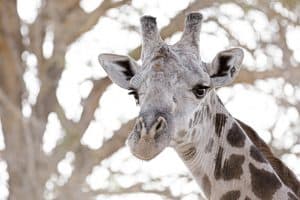It is believed that giraffes spots are first and foremost a type of camouflage. New technology also suggest that they also help with heat dispersal.
Why Do Giraffes Have Spots On Their Fur?

We are always learning new things about animals – and giraffes are no different. We humans only usually think about what we can see with our own eyes – and then assume what it means within the boundaries of what we think is possible in our own world.
However, animals have whole other worlds that they live in that we can’t even imagine.
They can see using heat, vibration, or sound; they can communicate in ways we can’t hear; and they can manipulate their bodies into doing things that are absolutely amazing. And until we started using special equipment and looking deeper into their lives – we had no idea!
Camouflage:
We usually assume that anything that has a patterned coat; looks the same color as their habitat or changes color; is doing so for camouflage. Based on what we see with our own eyes though – this is often quite hard to believe. Clearly – no matter what color it is – a full-grown giraffe really can’t hide anywhere? Anyone can see it.
However, once we started looking at different light wavelengths – and how the vision of predators (and biting insects) works – we started to realize that other factors were at work – not just straightforward ‘looking’. Understanding how the skin and eyes of different animals behave and interpret things, we get a much better understanding of why animal patterns evolved so differently in a range of species. And how these strange patterns on giraffes actually really do make them harder to ‘see’ and interpret as potential prey.
Heat Dispersal:
A more recent technological advance was discovered when scientists started looking at heat loss in giraffes and found that the places where a giraffe loses the most heat – matched almost exactly to the colored patches of spots on their coat.
On a thermal-imaging camera – the giraffe is identically-patterned to that which we see in normal light. The white areas are one color and the spots are another. An exact replica. Something not always seen in other highly-patterned mammals. It is thought that this was why the giraffe got its long neck – to help them cool off better as a longer neck can have more cooling patches?
Identity:
Although so many other factors are in play for giraffes to communicate with each other – there is the chance that a giraffe’s spots are a personal identity badge.
All giraffes have a unique pattern of spots – even within the range of different markings commonly seen in the regional sub-species – so much so that scientists can easily tell them apart from images alone. Also, the spots darken with age so they are giving out information about the status and age of the giraffe to others too.
Can You Get A Giraffe Without Spots?
Yes, you can get a giraffe without spots – but it is rather niche. It only happens in a very rare set of circumstances.
A giraffe’s spots are part of its very being and so you can’t get a giraffe born without their spots. The pattern of them is ingrained in their DNA. However – if the gene that makes the ginger color of their fur is switched off completely – then although they are still ‘there’ you won’t be able to see them.
So when would this ever happen? Well, see the next paragraph.
Can the Spots on a Giraffe’s Fur Help It Get Up If It Falls?
The unique patterns and spots on a giraffe’s fur not only make them visually spectacular but also serve a functional purpose. Contrary to what many might think, the giraffe’s ability to get up after a fall is not directly aided by the spots on its fur. Instead, it relies on its long and powerful legs, coordination, and muscular neck to gracefully rise back up, showcasing its remarkable physical abilities.
Are There Albino Giraffes?

Technically there are no albino giraffes. Even though this word is lazily overused – there are still ‘white’ giraffes for sure – they just aren’t albino.
Albino is a biological description for a series of specific genetic traits found to be expressed by a known genetic change. This change – as one of its defining features – removes all color from the animal – including the eyes – so albino individuals usually have only red or blue eyes. Many species have ‘true’ albino individuals – including humans – who have 7 different types.
However, as is the case with white giraffes – they have just lost the ability to make their traditional ginger color – so end up with pale skin and fur. When they are simply pale-colored but keep their dark eyes this is called leucism. Leucistic animals vary in pigment – so some can have just faded patches while others can be almost completely white.
Giraffes usually only go white where the fur is affected most by the genes – so white giraffes often keep most of their spots. There are very few leucistic giraffes that are 100% white and have no spots at all. This is incredibly rare in nature and it is believed that there is currently 1 single pure white giraffe in the world (2021) but this video in 2017 shows 2 such beauties together – mother and calf.




